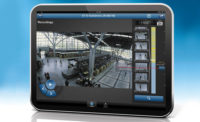In the security industry today, as in the world at large, mobile is no longer a nice-to-have feature; it’s a must-have. Customers want to be able to check in on their businesses (and homes) from wherever they are. With the vast majority of camera and VMS providers on board with this demand, the chances are excellent that there’s an app for that.
“We’re no longer becoming a wireless world; we are a wireless world,” says Jay Hauhn, chief technology officer and vice president of industry relations for Boca Raton, Fla.-based Tyco Integrated Security. “The end user experience with video entertainment on a mobile device has set a very high expectation for what security providers deliver to security practitioners. It’s a brave new world for the industry.”
Daniel McKimm, president and CEO of North Canton, Ohio-based Pro-Tech Security, says while technology got mobile adoption and popularity rolling, the ball is now in the manufacturers’ court to ensure that end users get the most out of their mobile surveillance solutions. “Without question, the main driving force toward mobile video solutions was the introduction and overwhelming adoption of smartphone technology. However, I see true mobile video solutions as relying on video manufacturers to share their SDKs and APIs in an open platform manner so their end users can avail themselves of tested and proven products and software,” he says. “Those manufacturers who choose to adopt a closed platform may well be sentencing their end users to ‘proprietary jail,’ restricting the future solution set they may need to meet their mission or their goals.”
Being on the front lines in terms of interacting and working closely with customers, integrators have an excellent perspective on this growing demand for mobile and remote video surveillance. In fact, one of the first questions out of a customer or prospective customer’s mouth is often, “Can I watch video on my phone?” So if you are not offering that functionality (at the very least), then it is time to start.
Other than the obvious “looky-loo” factor (for example, accessing live and recorded video just because they can), what is driving this demand? Setting aside the residential market (which is a different beast altogether), what do business owners and other commercial customers want from a mobile or remote solution? Moreover, is that functionality available to them? If so, are they aware of that and do they know how to get the most out of it?
These are just a few of the many important questions that need to be answered regarding mobile and remote video surveillance in the commercial sector. Even though most customers will jump at the capability and will be happy with it, you are actually doing them a disservice if you are not educating them about the features and functionality they want and need.
What End Users Want
More often than not, customers only want viewing capabilities because they are not aware of the added functionality that is out there.
“It’s mostly a convenience factor. They now have the ability to view live video from their smartphone, iPad or laptop. The cool thing is they can do it any time they want within a few seconds,” says Keith Maley, president of Harrisburg, Pa.-based Knight Security Systems. “They can see if employees are where they’re supposed to be or if customers are being taken care of in a timely fashion. Anything that you think of can be monitored remotely.”
So if you ask a customer point-blank what he or she wants to do with a mobile/remote video solution, don’t be surprised if you get, “I want to watch the video,” accompanied with a blank stare or confused look. It is your job to turn that confusion into excitement.
And that’s when the real work begins. First, be sure to learn all you can about the features and functionality of the mobile and remote solutions from the manufacturers you work with. Then, when you are meeting with a customer or potential customer, ask probing questions about their business and what specifically caused them to decide they needed a surveillance system. Again, you may not get much in response, but if you know what solution you’re trying to sell, you can develop questions that will help you determine if they’re interested in what they could do — and the business problems they could solve — with mobile and remote surveillance. You will know you have done it right when the look on their face tells you that the “aha” moment has struck. You will have become more than a vendor looking to sell them something; you will be perceived as a trusted source who took the time to help them understand how a video solution could improve their business.
Naturally, peace of mind is high on the list of end users’ wants when it comes to mobile video. For many, the functionality of a mobile solution starts and ends with knowing they can look in on a location at any time, from anywhere using their mobile device.
“People want to keep an eye on their properties and assets from anywhere they may be, including business trips or vacations,” Maley says. “Most people have access to the Internet 24 hours a day and want to be able to view and watch the things they work so hard for, whether it be a business location, vacation home or their prized boat they just purchased.”
However, if all a customer wants to do is look in — just because they can — they may wonder why they need a feature-rich (and somewhat costly) IP camera when they can simply buy and install a DIY solution. In their mind at least, they are probably better off buying a cheap webcam and installing an app like iCam on their smartphone.
It is your job to help customers understand the benefits of a full-featured IP camera (and the entire video system) that is designed specifically for security applications. It is your job to show why a professionally designed and installed mobile surveillance system is worth the investment. One tactic is to demonstrate potential cost savings a customer could realize using a mobile solution versus a Web interface on their computer (see related article, “Mobile or Remote?” on page 100).
“A stationary computer works great for viewing live or recorded images, but in most applications it’s not realistic in today’s busy lifestyle,” Maley says. “In a business setting, unless you have a guard watching the video full-time, it’s not cost-effective to have somebody sitting there and watching the video. With the enhancements of mobile video over the last few years, it’s not necessary to have full-time personnel watching the video.”
That makes highlighting the potential for mobile to turn video surveillance from a cost into a cost-saving application one of the main points you have to help customers understand.
“First of all, you don’t have to have as many personnel physically checking the locations when they can be viewing them remotely,” Maley says. “This in turn means less expense to the business because they can do it with fewer guards on duty.”
In fact, Hauhn says, those people can be based somewhere other than the location they are charged with protecting, potentially allowing a business to occupy a smaller footprint. “Mobile video allows for job and location flexibility. Security personnel professionals do not have to be at a physical business location to interact with and control that location’s security infrastructure,” he says.
Enhancing Security
As if cost savings were not enough, McKimm says employing a mobile solution also boosts the efficiency and performance of a customer’s current security operations. “It is a force multiplier for the security officer whose responsibilities may extend beyond just an area where he has line-of-sight viewing. For instance, a properly designed video surveillance system can integrate those cameras via wireless and/or LAN or WAN to give that officer situational awareness security control that he would otherwise not have,” he says. “Best of all, he can demonstrate an ROI to the C-suite using this force multiplier example. In other words, they can deploy one officer where two or even three used to be deployed to cover the same area.”
Another key security enhancement mobile provides is video verification, which has become more of a front-and-center issue for municipalities across the country.
“End users need real-time or near real-time event-driven video access to verify alarms,” McKimm says. “They need to be able to identify conditions and situations at their home as well as their business, whether it’s identifying who is ringing their doorbell, the status of the family pet, the activity at the office or the progression of a project at a remote location for which they have responsibility or oversight.”
In many situations, mobile surveillance also increases the safety of security personnel and first responders by providing awareness of and intelligence about a scene before they arrive, Maley says. “We are currently working with a city and their police department so they can watch video from a command center and police cruisers at problem locations all over the city. That way the responding officer or command center can have more details when the first officers arrive on the scene. Hopefully, they will have a better description of the situation and more importantly, know if they are entering a dangerous situation,” he says.
Paul Timm, PSP, president of Reta Security, a Lemont, Ill.-based firm that specializes in consulting, designing and updating security systems for the education market, underscores this point, citing the ability to share video from a scene with several people across and outside of an organization, whether they are based in an office or in the field.
“The ability to share an active crime scene while it is occurring with multiple staff other than just the dispatcher allows for better decision-making and planning before and during an event. The ability to capture an image of a suspect and relay that information to the staff on patrol reduces the time and improves the suspect description tenfold,” Timm describes.
An extension of active crime scene sharing is the relatively new concept of reverse surveillance. Currently, a handful of providers offer end users the ability to turn their smartphones into mobile surveillance cameras and provide live video from a remote location that can be shared across the network. Many more providers are working on offering this functionality in the near future.
“Advances in VMS even allow for using a smartphone in reverse, so to speak. For example, a person, or more specifically a security officer, could license the camera within his smartphone for relaying live video streams via some VMS. This makes his mobile video an intelligent camera subset of that surveillance camera network to record and stream live video of a crime or event in progress direct from his location. This would allow anyone else on that network to take over the situation awareness control by perhaps summoning the police to that location or alerting others as dictated by company standard operating procedures,” McKimm says.
Looking Ahead
It is never easy to predict the future, but given the tremendous growth of mobile solutions, “onward and upward” is probably a safe bet for the direction of mobile in the security industry. Beyond that, there are a few specific features and functions that could help speed growth.
“It seems like the next step would be the addition of more and more cameras, and that might be what administrators want to implement,” Timm says. “Increased lighting would place a close second in the need to reduce dark or blind spots, and zoom-in technology will be in high demand from the technology side of things.”
Combined with increased speeds of mobile networks, smarter cameras — and more of them — will also become more common, McKimm says. “Cameras will not only become ubiquitous, but also more intelligent as we develop analytics that are more effective and reliable. Situational awareness control will allow for the integration of these cameras beyond what we know today as VMS,” he says. “The integration and convergence of cameras, access control, intrusion detection devices, mass notification, fire alarm systems and even building automation will automate and control down to the end user and/or first responder’s smartphone for assessment and response.”
Increased use of mobile for surveillance will create greater familiarity with the technology and should contribute to its continued growth.
“The more a staff person uses these devices and acquires better abilities to use them, the more the systems will grow,” Timm says.
So while most end users simply want the ability to view live and recorded video from their smartphone, as they become more aware of the possibilities, more features will be available to them. Eventually, like mobile apps themselves, it will just become de rigeur.
“Down the road, the possibilities are endless with enhancements in technology,” Maley says. “I believe that you will be able to very easily view, record and email video clips of a situation in a matter of seconds from your phone or iPad without even thinking about it. That ability will be second nature.”
Mobile or Remote?
Mobile and remote surveillance may sound the same, and the terms are often used interchangeably in conversation, but there are actually several important differences between the two.
Mobile surveillance is specific to smartphones or tablets and allows users to check on their IP video system from places where it is not possible with a PC or laptop. Apps make monitoring and managing cameras and video (live and recorded) as simple as possible. However, generally speaking, mobile apps typically provide fewer features and less functionality than Web interfaces that users can access using their computers.
For the most part, remote surveillance is done through a Web interface using a computer. These interfaces tend to offer a larger array of features than mobile apps, including a broader menu of playback features. The larger screen also size allows users to more carefully scrutinize their video, and exporting video is often easier than on a smartphone or tablet.
Each has its pros and cons, and often end users want to use both to complement each other. However, the industry is moving away from hardwired, stationary solutions.
“Today’s culture and their reliance on being mobile won’t allow for retreating to the archaic means of access or being chained to a desktop. For that reason alone, desktop restrictions wouldn’t work ‘just as well,’” says Pro-Tech Security’s Daniel McKimm. “Think of it as if we would have to go back to the days of retrieving a phone book directory to locate and speak to someone, and being restricted to the phone for our business without the use of email or texting.”
Can a stationary solution for viewing live and/or archived video work just as well as a mobile solution?
“Sure, but you can also cook over a wood fire or watch a video on a VCR,” says Tyco Integrated Security’s Jay Hauhn. “People are mobile. We’re at the tipping point where the mobile experience must be equal to or better than interaction at a desktop.”
While you can’t beat mobile for rapid response to events, a stationary surveillance solution is still the best choice in terms of image quality and speed of access, believes Paul Timm of Reta Security. “You just can’t beat hardwired speed and completeness,” he says. “Continual wireless connectivity is still a challenge in many locations, and though it is improving, much more needs to be done.”
It’s About Time
Strip away the cool factor of mobile surveillance and what it allows end users to do. When it comes down to it, one of the main reasons — along with the ever-improving technology — mobile is moving forward at such a rapid pace is something no amount of money can buy. There simply are not enough hours in the day.
“Time is one of our most precious resources,” says Jay Hauhn of Tyco Integrated Security. “Our customers are always on the go and mobile video solutions allow them to manage their security systems from remote locations around the world via their smartphone, tablet or laptop.”
Recognizing that reality, Tyco Integrated Security is introducing a new mobile solution designed to save both time and money. “Mobility is the future. Today’s always-on, always-connected workforce is one of the reasons why Tyco Integrated Security developed its Mobile Security Management system,” Hauhn says. “ We pride ourselves on understanding our customers’ needs, and have now given them the ability to remotely manage their security systems to improve productivity and enhance security protection conveniently and affordably, providing the type of technology they have come to expect from us.”
MORE ONLINE
Given end users’ demand for mobile video solutions, nearly every camera and VMS provider has some sort of smartphone app to make viewing live and recorded video (at bare minimum) as easy as possible. For a list of those apps, visit www.sdmmag.com/mobile-video-chart.









